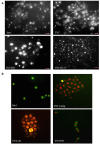Bridge-Induced Translocation between NUP145 and TOP2 Yeast Genes Models the Genetic Fusion between the Human Orthologs Associated With Acute Myeloid Leukemia
- PMID: 29034209
- PMCID: PMC5626878
- DOI: 10.3389/fonc.2017.00231
Bridge-Induced Translocation between NUP145 and TOP2 Yeast Genes Models the Genetic Fusion between the Human Orthologs Associated With Acute Myeloid Leukemia
Abstract
In mammalian organisms liquid tumors such as acute myeloid leukemia (AML) are related to spontaneous chromosomal translocations ensuing in gene fusions. We previously developed a system named bridge-induced translocation (BIT) that allows linking together two different chromosomes exploiting the strong endogenous homologous recombination system of the yeast Saccharomyces cerevisiae. The BIT system generates a heterogeneous population of cells with different aneuploidies and severe aberrant phenotypes reminiscent of a cancerogenic transformation. In this work, thanks to a complex pop-out methodology of the marker used for the selection of translocants, we succeeded by BIT technology to precisely reproduce in yeast the peculiar chromosome translocation that has been associated with AML, characterized by the fusion between the human genes NUP98 and TOP2B. To shed light on the origin of the DNA fragility within NUP98, an extensive analysis of the curvature, bending, thermostability, and B-Z transition aptitude of the breakpoint region of NUP98 and of its yeast ortholog NUP145 has been performed. On this basis, a DNA cassette carrying homologous tails to the two genes was amplified by PCR and allowed the targeted fusion between NUP145 and TOP2, leading to reproduce the chimeric transcript in a diploid strain of S. cerevisiae. The resulting translocated yeast obtained through BIT appears characterized by abnormal spherical bodies of nearly 500 nm of diameter, absence of external membrane and defined cytoplasmic localization. Since Nup98 is a well-known regulator of the post-transcriptional modification of P53 target genes, and P53 mutations are occasionally reported in AML, this translocant yeast strain can be used as a model to test the constitutive expression of human P53. Although the abnormal phenotype of the translocant yeast was never rescued by its expression, an exogenous P53 was recognized to confer increased vitality to the translocants, in spite of its usual and well-documented toxicity to wild-type yeast strains. These results obtained in yeast could provide new grounds for the interpretation of past observations made in leukemic patients indicating a possible involvement of P53 in cell transformation toward AML.
Keywords: P53; acute myeloid leukemia; bridge-induced translocation; gene fusion; nucleoporin; yeast.
Figures








Similar articles
-
NUP98 is fused to topoisomerase (DNA) IIbeta 180 kDa (TOP2B) in a patient with acute myeloid leukemia with a new t(3;11)(p24;p15).Clin Cancer Res. 2005 Sep 15;11(18):6489-94. doi: 10.1158/1078-0432.CCR-05-0150. Clin Cancer Res. 2005. PMID: 16166424
-
NUP98-PHF23 fusion is recurrent in acute myeloid leukemia and shares gene expression signature of leukemic stem cells.Leuk Res. 2016 Jun;45:1-7. doi: 10.1016/j.leukres.2016.03.006. Epub 2016 Mar 30. Leuk Res. 2016. PMID: 27060678
-
NUP98 is fused to PMX1 homeobox gene in human acute myelogenous leukemia with chromosome translocation t(1;11)(q23;p15).Blood. 1999 Jul 15;94(2):741-7. Blood. 1999. PMID: 10397741
-
A cryptic translocation leading to NUP98-PHF23 fusion in AML.Best Pract Res Clin Haematol. 2016 Dec;29(4):320-323. doi: 10.1016/j.beha.2016.10.002. Epub 2016 Oct 18. Best Pract Res Clin Haematol. 2016. PMID: 27890253 Review.
-
Per aspera ad astra: When harmful chromosomal translocations become a plus value in genetic evolution. Lessons from Saccharomyces cerevisiae.Microb Cell. 2015 Aug 20;2(10):363-375. doi: 10.15698/mic2015.10.230. Microb Cell. 2015. PMID: 28357264 Free PMC article. Review.
Cited by
-
Case Report: Multiple Chromosomal Translocations Including Novel CIITA-CREBBP Fusion and Mutations in a Follicular Lymphoma.Front Oncol. 2021 Mar 10;11:620435. doi: 10.3389/fonc.2021.620435. eCollection 2021. Front Oncol. 2021. PMID: 33777766 Free PMC article.
-
Editorial on the Research Topic 'Cell Differentiation, Oxidative Stress, and Oxygen Radicals-In Honor of Prof. Michael Breitenbach'.Biomolecules. 2024 Jul 29;14(8):920. doi: 10.3390/biom14080920. Biomolecules. 2024. PMID: 39199308 Free PMC article.
References
Grants and funding
LinkOut - more resources
Full Text Sources
Other Literature Sources
Molecular Biology Databases
Research Materials
Miscellaneous

